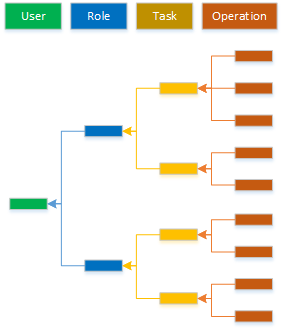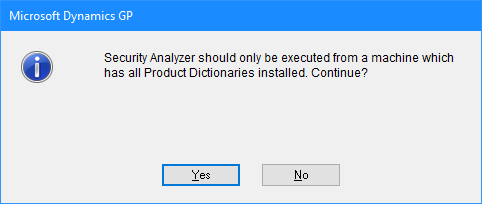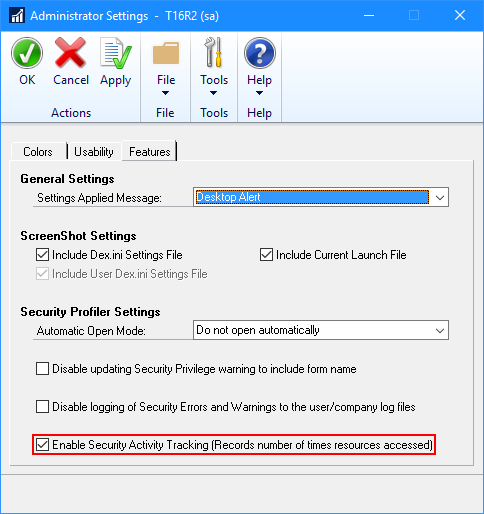 This post is part of the Hands On With the GP Power Tools (GPPT) – Administrator Tools series in which I am taking a hands on look at the various tools offered by GPPT.
This post is part of the Hands On With the GP Power Tools (GPPT) – Administrator Tools series in which I am taking a hands on look at the various tools offered by GPPT.
The Security Hidden () window works in the same way as the Security Denied one:
 This post is part of the Hands On With the GP Power Tools (GPPT) – Administrator Tools series in which I am taking a hands on look at the various tools offered by GPPT.
This post is part of the Hands On With the GP Power Tools (GPPT) – Administrator Tools series in which I am taking a hands on look at the various tools offered by GPPT.
The Security Hidden () window works in the same way as the Security Denied one:
 This post is part of the Hands On With the GP Power Tools (GPPT) – Administrator Tools series in which I am taking a hands on look at the various tools offered by GPPT.
This post is part of the Hands On With the GP Power Tools (GPPT) – Administrator Tools series in which I am taking a hands on look at the various tools offered by GPPT.
The Enhanced Security window is good for configuring deny baed security for a user, but is not great for reviewing what has been configured. Instead there is a Security Denied () window available:
The Security Denied window is also used for maintenance, exporting and reporting of the Deny Based Security — Security Denied data. Using this window allows all the Security Denied for users to be easily viewed without having to explore the tree views on the Enhanced Security window.
Changes made in the window are made immediately and do not need the OK Button to be clicked.
As the image above shows, when a user is selected, the Security Denied items are listed in the scrolling window. You can use the checkboxes to restrict the types of item shown. Marking an item allows it to be removed from Deny Based Security by clicking the Delete button.
By changing the Display Mode drop down you can change the view between the following four options:
The ability to view all of the configuration at the same time is a very good one, which is an absolute necessity.
You can use the Export button to export the content of the scrolling window to either file or email. The export is of every item in the list and not just the selected ones; the intended purpose of this is for auditing security configuration.
 This post is part of the Hands On With the GP Power Tools (GPPT) – Administrator Tools series in which I am taking a hands on look at the various tools offered by GPPT.
This post is part of the Hands On With the GP Power Tools (GPPT) – Administrator Tools series in which I am taking a hands on look at the various tools offered by GPPT.
The Enhanced Security window () allows you to view the security resources and/or operations via the navigation (menus and area pages) or dictionary model:
 This post is part of the Hands On With the GP Power Tools (GPPT) – Administrator Tools series in which I am taking a hands on look at the various tools offered by GPPT.
This post is part of the Hands On With the GP Power Tools (GPPT) – Administrator Tools series in which I am taking a hands on look at the various tools offered by GPPT.
Microsoft Dynamics GP’s security is constructed on a pessimistic security role and task model (users have no access unless granted); an operation (such as the ability to open a window or print a report) is assigned to a task which is, in turn, assigned to a role, which are then assigned to a user or, preferably, multiple users:

 When, in my Hands On With the GP Power Tools — System Module series, I covered the Screenshot tool which allows users to send screenshots of problems to the administrator. The email also includes a system status report which, in the current version, includes information on the system and all company databases. This is usually fine, but I have one client who has 200+ databases and the email takes a long time to generate the report.
When, in my Hands On With the GP Power Tools — System Module series, I covered the Screenshot tool which allows users to send screenshots of problems to the administrator. The email also includes a system status report which, in the current version, includes information on the system and all company databases. This is usually fine, but I have one client who has 200+ databases and the email takes a long time to generate the report.
I mentioned this to Winthrop DC and they have confirmed that the next build of GP Power Tools will include some new functionality to address this issue.
A new option has been introduced, which defaults to off, which will include only the system and current database in the system status report; setting the option to on will add all company databases to the system status report.
The value is stored in Administrator Settings for normal use and on the Trigger Setup window for when Triggers are created to use the ScreenShot feature.
 This post is part of the Hands On With the GP Power Tools (GPPT) – Administrator Tools series in which I am taking a hands on look at the various tools offered by GPPT.
This post is part of the Hands On With the GP Power Tools (GPPT) – Administrator Tools series in which I am taking a hands on look at the various tools offered by GPPT.
The Security Analyzer is a tool for administrators to analyze the security settings of their Microsoft Dynamics GP system. It is designed to highlight potential security risks, provide information on unused settings as well as provide a comparison between security access and security resources actually used.
The Security Analyzer has over twenty queries which can be displayed in both Summary and Detail formats. The queries are divided into System Level queries and User & Companies queries. For the Users & Companies queries, you can select the User and/or Company to limit the query data to.
Be aware, some of the queries in the Security Analyzer window use the Security Log window’s activity data captured by the Security Activity Tracking option enabled from the Administrator Settings window, which I covered in this post.
Once the data is displayed, it can be exported if desired, or used to drill down to the relevant system windows to be able to make changes to the system and security settings.
When you launch Security Analyzer (), you will be prompted to confirm that you are on a machine whiuch has all Product Dictionaries installed; click Yes to proceed:

Continue reading “Hands On With the GP Power Tools – Administrator Tools: Security Analyzer”
 This post is part of the Hands On With the GP Power Tools (GPPT) – Administrator Tools series in which I am taking a hands on look at the various tools offered by GPPT.
This post is part of the Hands On With the GP Power Tools (GPPT) – Administrator Tools series in which I am taking a hands on look at the various tools offered by GPPT.
The Security Log window displays the data captured by the Security Activity Tracking option which can be enabled from the Administrator Settings () window using the Enable Security Activity Tracking option (ringed in red):

Continue reading “Hands On With the GP Power Tools – Administrator Tools: Security Log”
 This post is part of the Hands On With the GP Power Tools (GPPT) – Administrator Tools series in which I am taking a hands on look at the various tools offered by GPPT.
This post is part of the Hands On With the GP Power Tools (GPPT) – Administrator Tools series in which I am taking a hands on look at the various tools offered by GPPT.
The Security Information () window can display the security settings for the selected resource for a particular user and company combination.
This is a great way of reviewing how security is configured and which roles/tasks or users have access to the different forms or other resources.
In this post, I’m going to take a look at the configuration around the Transaction by Vendor () window. To view this security information, open the window and click the blue bar containing Security Information for specified Resource and select Select Form (By Menu):
Continue reading “Hands On With the GP Power Tools – Administrator Tools: Security Information”
 A few days ago Derek Albaugh posted to the Dynamics GP Support and Services Blog about the Dynamics GP Support and Services Blog end of lifecycle for Microsoft Dynamics GP 10. This is a version launched way back in 2007 and is eight major versions behind the current release.
A few days ago Derek Albaugh posted to the Dynamics GP Support and Services Blog about the Dynamics GP Support and Services Blog end of lifecycle for Microsoft Dynamics GP 10. This is a version launched way back in 2007 and is eight major versions behind the current release.
Mainstream Support ended in 2012, so this is the end of Extended Support.
To be clear what this means, Mainstream Support means no design changes or feature requests or year-end or tax updates; the end of Extended Support means that there is no longer any paid support (per-incident, per hour or other) for this version of Microsoft Dynamics GP.
Continuing to run Microsoft Dynamics GP 10 means you are running a non-supported version of your ERP system; this is a major business risk so I, as well as Microsoft, would very strongly recommend planning your upgrade to a supported version.
I posted a link to details of lifecycles for other versions of Microsoft Dynamics GP here.
 This post is part of the Hands On With the GP Power Tools (GPPT) – Administrator Tools series in which I am taking a hands on look at the various tools offered by GPPT.
This post is part of the Hands On With the GP Power Tools (GPPT) – Administrator Tools series in which I am taking a hands on look at the various tools offered by GPPT.
As well as allowing you to see to which windows a user does not have access, Security Profilers () can also be used to construct new Security Tasks. To use this particular function in the window, the logged in user needs to have access to the standard Security Tasks () window.
When the user does have this access, the Security button on the Security Profiler windows action pane, will have a new Start Capture of Resources and Security Objects option available: